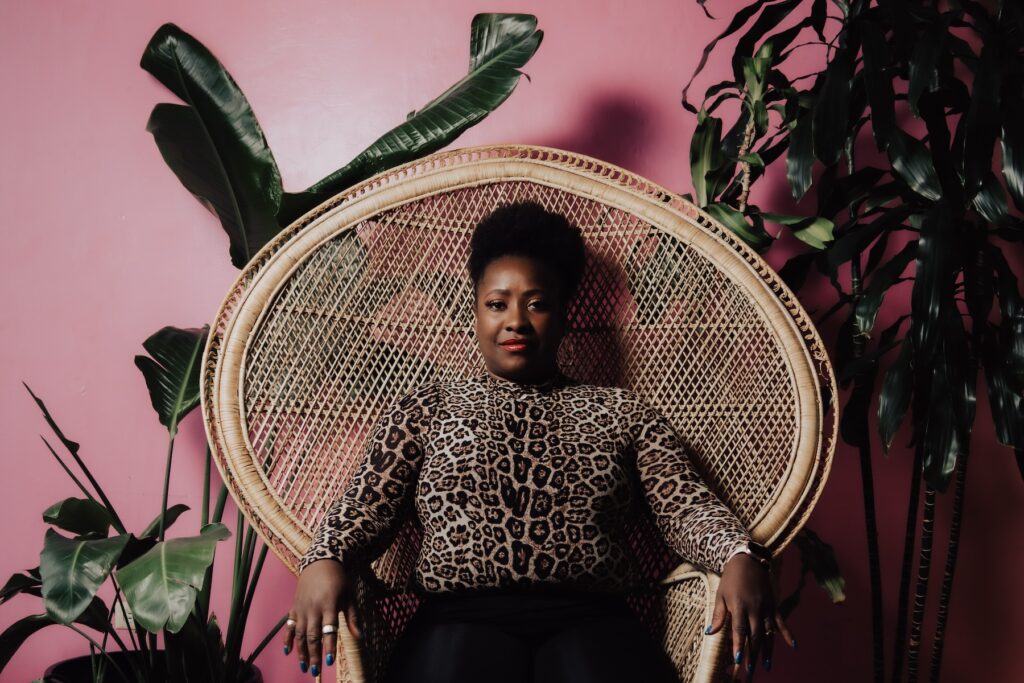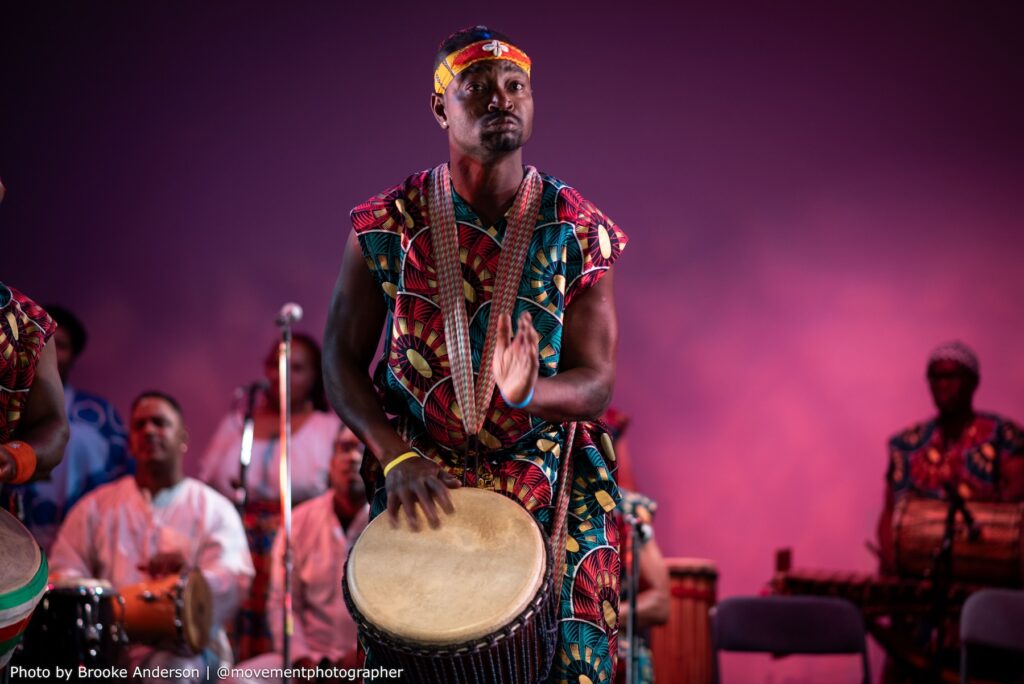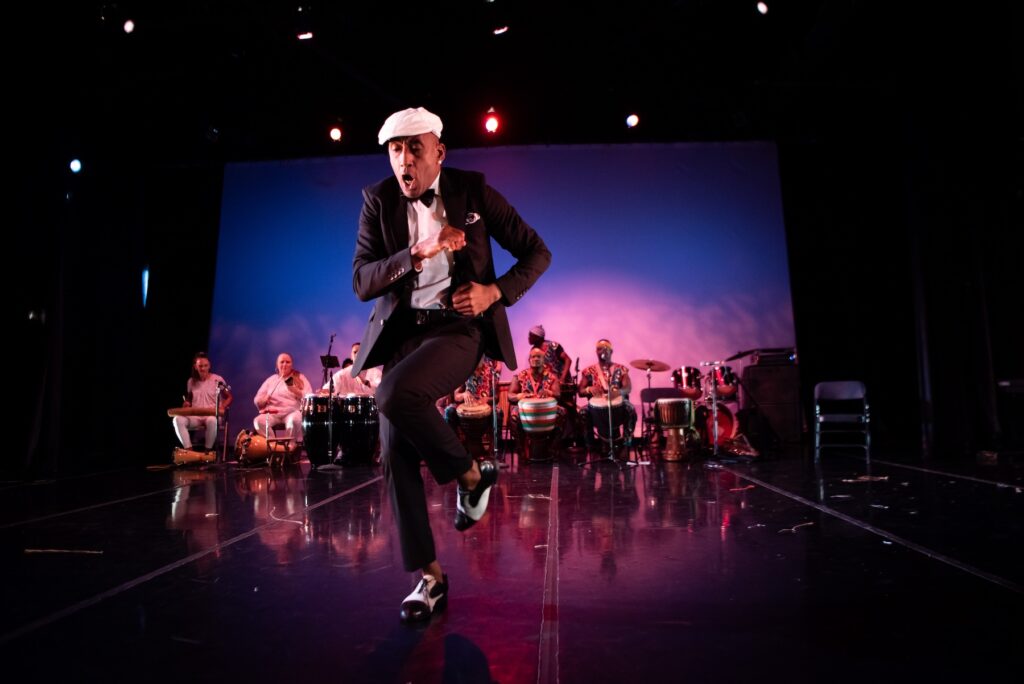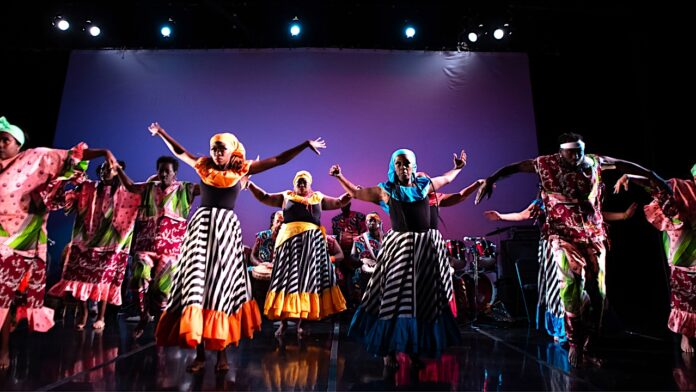Composer-musician Bongo Sidibe tells me that he and choreographer Susana Arenas Pedroso had never worked together before deciding to create their massive new work, Raíces et Résistance (Fri/11-October 20, Dance Mission Theater, SF). “We’re like a family now,” he says. For the past four years Sidibe, who is from Guinea, and Pedroso, who is from Cuba, together have been researching the intertwined histories of their countries and the parallel experiences of their people to create Raíces et Résistance, which they tell me is about both celebration and reclamation.
Embodying the past and the present, Raíces et Résistance is a story of Black people defining themselves through dance and music during and after the traumas of slavery and colonization. “Often stories of African and Caribbean nations are predicated on their relationships to the white western world,” explains Sidibe. “This project, while attached to the history of colonization and slavery, looks at independent nations carving out their own identities, Afro-diasporic, immigrant artists collaborating to inspire collectivity and community, and the examination of how people emerge from collective trauma through art.”
With his company, Duniya Dance and Drum, which he co-directs with choreographer Joti Singh, a producing collaborator on this project, Sidibe creates what he calls activist projects, works that “value our history and cultures.” He adds, “We hear a lot about Cuban musicians collaborating with African musicians, but something like this I think really is the first time. It’s important that we connect with each other. It’s like when you separate two members of a family and then they find each other.”
Pedroso explains, “My work showcases my Afro-Latinidad identity. I am all of these things: Cuban, but also immigrant, Black, and Latina. My art elevates Afro-Latinx art to its rightful position of being celebrated for its beauty, wisdom, and deep intelligence. The social issues addressed in my work are the representing and transmitting of traditional knowledge rooted in my ancestors.”
History is central to Raíces et Résistance. After French colonization ended in 1958, Guinea elected socialist president Sekou Touré, one of the African continent’s prominent independence leaders. Touré aligned closely with Cuba’s Fidel Castro and through this alliance came cultural exchange between the two countries. Artists were invited to festivals by the governments of both countries, and national music groups in Guinea, like Bembeya Jazz, created music with heavy Cuban influence.

Raíces et Résistance explores different historical eras, namely colonial, independence, and modern times, through a non-linear storyline. ”We’re exploring the history and creating a new form of storytelling,” says Sidibe. Pedroso adds, “A lot of people don’t know the history, but from this show people will know the real truth.” As the generations of the late 1950s and early 1960s age and gradually die out, however, there is a particular urgency to document the past accurately with first hand accounts of people who were there.
As part of their research Sidibe and Pedroso traveled together to both Cuba and Guinea to engage with the local people, including musicians and dancers. “We’ve got to tell our story now,” says Pedroso. “Cuba was the first country to go to Africa to help our brothers and sisters during their revolution against French colonialism. Sixty-five years ago when Castro was president, there were a lot of good things like healthcare, education, and employment, but now things are not good. To say ‘revolution’ to people now in Cuba is very sad.”
The sense of family when they met was carried with them when they visited each other’s countries. While visiting Guinea, Pedroso recounts teaching a workshop to which nearly 100 dancers and musicians came. She taught the orishas (Cuban religious dances) and salsa, which she says the Guinean artists immediately understood, despite the language barrier. She still marvels that she was able to cue the musicians and dancers so easily because of what she says is a deeply rooted mutual understanding.
Help us save local journalism!
Every tax-deductible donation helps us grow to cover the issues that mean the most to our community. Become a 48 Hills Hero and support the only daily progressive news source in the Bay Area.

Outside of classes and workshops, Sidibe and Pedroso say there were many other poignant moments of intimate connection, like when Pedroso sang an African song she had learned growing up which Sidibe immediately recognized. Or upon meeting Sidibe’s father when Pedroso exclaimed, “Bongo, your dad looks like my uncle in Cuba!” Or when they traveled together to the coast where slave ships used to dock, a place Sidibe had known about but never visited because his father had forbidden it. “It’s very heavy. Stories have to be told, so people can learn from it and correct wrongs, but we want to be careful about the trauma that has been caused,” Sidibe explains.
Creating Raíces et Résistance has been a process of many first encounters all adding up to a deep and empowering sense of family. Pedroso recalls, “When Bongo went to Cuba, we thought he was Cuban. There is something ancestral about him. When I was in Guinea they treated me like a sister.” Sidibe adds, “We connected as soon as we saw each other. These are our people. It feels like we’ve worked together for 20 years. It’s a deep connection. Those guys are like my brothers and sisters.”
Filling Dance Mission Theater, a collaborating producer on this project, for the two week run of Raíces et Résistance is the cast of 25 dancers and 15 musicians, some originally from Cuba and Guinea and others who live here in the United States. Sidibe says, “I feel like we are building bridges for all the diasporas.”
When asked what it is like to present a work like this in the U.S., he replies, “Sometimes I have a hard time here because people don’t always want to hear the stories of the past, so I look for ways to share them. The Bay Area is one of the most diverse places in the country so it’s a good place to do this.”

Pedroso explains, “When we moved to the US we had to teach American students. It’s the only way we keep the culture here. The new generation, they teach, but they don’t tell the history. We have to be clear about how they use their faces and the dancers have to sing. I want the audience to be emotional.”
Co-producer Stella Adelman of Dance Mission Theater says, “What’s also important about Raíces et Résistance is that it’s two immigrant artists with African roots coming together to create. What happens when immigrant artists get to use each other as an inspiration and a resource?”
Sidibe points out that most Black traditional artists don’t usually get adequate funding support or know how to work the American systems to produce work of this scale.“ I feel like this is the first time I’ve heard about an Guinean and Cuban artist collaborating traditionally,” Sidibe reflects. Pedroso adds, “It’s vital that these Afro-Latinx forms are represented as part of the multicultural fabric of the US. As a traditional practitioner, I am part of the movement to let ancient wisdoms speak to us across generations/continents, guiding society to a more equitable future.”
An added bonus, audiences will have the opportunity to see a documentary film by Joanna Ruckman of the making of Raíces et Résistance, including footage of the artists’ travels to Cuba and Guinea. The screening, which precedes the live performances, is included with the price of admission. On Friday, October 12 at 1pm at Dance Mission there is also a free Cuban and Guinean dance class with the artists of Raíces et Résistance, giving audience members the chance to dive deeper into the material explored on stage. Registration is required.
RAÍCES ET RÉSISTANCE Fri/11-October 20 at Dance Mission Theater, SF. Tickets and more info here.





